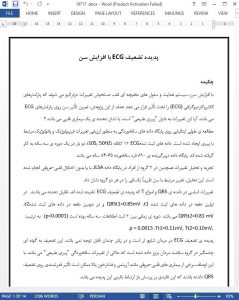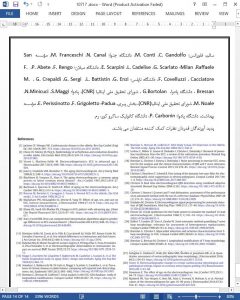Abstract
With advancing age, the conduction system and heart muscle cells undergo degenerative alterations affecting the electrocardiographic (ECG) parameters. The goal of the study is to determine the effect of age on ECG parameters. Are these changes due to a ‘normal aging’ or are they indicative to a ‘heart disease’?
Italian Longitudinal Study on Aging (ILSA) database has been created to evaluate physiologic and pathologic modifications connected with aging. Standard 12-leads ECG recordings (10 s, 500 Hz) have been taken twice in a period of three years. The database consists of 890 individuals aged 65–84 years.
Analysis of changes has been done also in two groups of individuals in ILSA database – with and without cardiovascular abnormality. This analysis showed a nearly equal age-related change in both groups.
The main changes are reduction in the amplitudes of QRS- and T-waves, referred as ‘ECG attenuation phenomenon’. QRSt1 = 0.85 mV at the time of the first recording t1, and QRSt2 = 0.81 mV at the time of the second recording t2, the period between the two recordings being three years (p b 0.0001). Respectively Tt1 = 0.11 mV, Tt2 = 0.10 mV, p = 0.0013.
ECG attenuation phenomenon is more common in males, and it is not significant in females. This attenuation is manifested significantly also in healthy male group, suggesting geriatric changes of “normal aging”. Nevertheless, some cardiovascular diseases, such as arrhythmias and hypertension, may have a strong influence on the QRS attenuation, and this supports the open question of the clinical relevance of the phenomenon.
ECG attenuation phenomenon is more manifested in younger individuals and occurs independently of body mass. ECG attenuation phenomenon is a significant fact, and therefore it should be considered in any serial ECG study, for example in the ECG analysis for human identification.
Introduction
Normal aging is associated with a multitude of structural and functional changes in the cardiovascular system. Heart aging is manifested in increased heart's mass and fibrosis of the conduction system. Evidence for outcomes of recommended treatments for prevalent cardiac conditions in the elderly is lacking because generally the trials either included few elderly patients or excluded the elderly completely [1–3].
The occurrence of widespread histologic changes in the conduction system may alter several features of the aging electrocardiogram (ECG), including duration of the PR and QT intervals, orientation of the electrical axis, duration and morphology of the atrial and ventricular complexes, and characteristics of ventricular repolarization [4].
Conclusions
Geriatric changes of the ECG are observed and reported in the literature. The analysis of serial changes, 3 years apart, in a group of individuals with/without cardiovascular diseases of the ILSA database showed significant age-related changes.
The main ECG alteration that we observed was a reduction in the amplitudes of the QRS- and T-waves, referred as ‘ECG attenuation phenomenon’. This phenomenon was present in males and was insignificant in females. Significant ECG attenuation in male healthy group suggests geriatric changes to “normal aging”, although some cardiovascular diseases may have a strong influence on the QRS attenuation. In the age range of the ILSA contingent, the ECG attenuation was more manifested in the younger group. ECG attenuation phenomenon with advancing age, however, is a significant fact, and should be considered in any serial ECG study, for example when using ECG for human identification.











